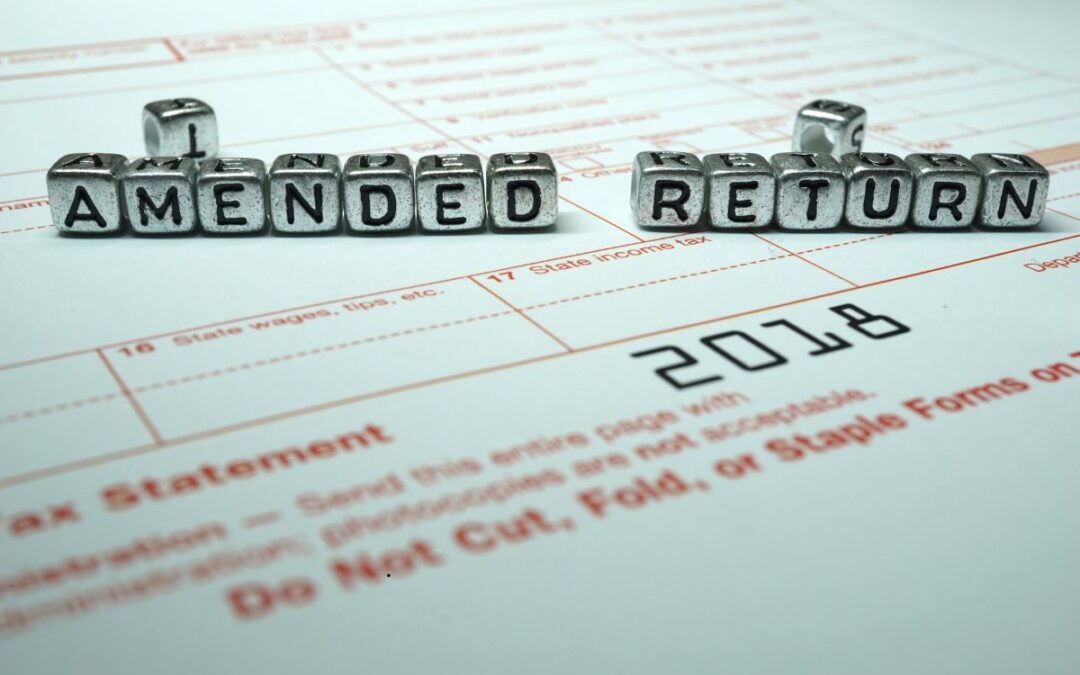Tax return mistakes happen more often than you think. The good news is they’re completely fixable. The IRS created Form 1040-X specifically for taxpayers to correct errors. This form helps you fix mistakes on previously filed returns. Common tax corrections include reporting missed income or claiming forgotten deductions. You can also update your filing status if needed. The amendment process is straightforward and designed for everyday taxpayers. Many people successfully amend their returns without professional help. This guide explains everything about the tax amendment process. You’ll learn when to file corrections and what to expect. Understanding these steps helps reduce stress about tax mistakes. Remember, the IRS expects some errors and provides clear correction procedures. Taking action quickly ensures you stay compliant with tax laws. Let’s explore how tax amendments work and their typical timeline.

Can You Fix Mistakes on Your Tax Return?
Everyone makes mistakes, including on tax returns. Fortunately, the tax system allows corrections through amended tax returns. The IRS understands errors happen and provides clear correction methods. Form 1040-X lets you fix problems on already-filed returns. This process helps taxpayers stay compliant and claim proper benefits. Knowing when and how to amend saves time and money. Let’s explore the amendment process and important deadlines.
When Should You File an Amended Return?
Several situations require filing an amended tax return. Missing a deduction or credit is the most common reason. Choosing the wrong filing status also needs correction through amendment. Adding or removing dependents requires an amended return too. Forgetting to report income creates another amendment situation. Claiming ineligible expenses or credits needs immediate correction. Each situation has specific rules and procedures to follow.
Important Tax Professional Advice
Tax professionals recommend waiting before filing amendments. Let the IRS process your original return first. Sometimes they catch errors and fix them automatically. This saves you from unnecessary paperwork and waiting. Professional guidance helps avoid common amendment mistakes. Their experience speeds up the correction process significantly.
When You Don’t Need to Amend
Not every mistake requires an amended return. Math errors usually get corrected automatically by IRS computers. Simple clerical mistakes also receive automatic adjustments. The IRS sends bills for additional taxes when needed. They also issue tax refunds if errors favor you. Understanding these exceptions saves unnecessary filing work.
Is Filing an Amendment Required?
The IRS can review returns from previous years. This review process might reveal additional taxes owed. While audits typically cover three recent years, older returns remain reviewable. Filing amendments promptly helps avoid potential problems later. Quick action minimizes any penalties or interest charges. Being proactive shows good faith to tax authorities.
Amendment Filing Deadlines
Time limits exist for filing amended returns. You have three years from the original deadline. Alternatively, you get two years from paying taxes. The later date applies for refund claims. Missing these deadlines means losing refund opportunities. Mark your calendar to avoid missing important dates. Understanding deadlines helps protect your financial interests.

How Do You File an Amended Tax Return?
Filing an amended tax return follows a simple step-by-step process. Understanding each step helps ensure successful amendments. The IRS designed this process for regular taxpayers to use. Most people can complete amendments without professional help. Following proper procedures prevents delays and additional errors. Let’s walk through each step of the amendment process.
Step 1: Gather Your Important Documents
Start by collecting your original tax return and supporting papers. You’ll need these documents to prepare accurate corrections. New or corrected W-2 forms help fix income reporting errors. Updated 1099 forms also support income corrections when needed. Missing deduction claims require proper supporting documentation too. Charitable donation receipts prove your deduction eligibility clearly. Mortgage interest statements support home-related deduction claims. Education credit claims need Form 1098-T from your school. Having all documents ready speeds up the amendment process.
Previous tax software users can access returns online easily. Most programs save copies you can download and print. Check your computer for saved PDF copies too. These digital records make amendments much simpler to complete. If you lack copies, the IRS provides alternatives. Their online Get Transcript tool offers free tax transcripts. These transcripts show your filed return’s key information. The transcript includes income, deductions, credits, and payment details. This information helps recreate your original return accurately. Proper documentation ensures your amendment succeeds without delays.
Step 2: Obtain the Correct Tax Forms
Form 1040-X is the main document for tax corrections. This form works for all individual tax return amendments. You’ll also need schedules affected by your changes. Each type of correction requires specific supporting forms too.
Itemized deduction changes require Schedule A from that year. Adding missed interest or dividends needs Schedule B forms. Business income corrections typically require Schedule C and SE. Investment changes might need Form 8949 and Schedule D. Getting the right forms prevents processing delays later. Each tax year has its own specific form versions.
Tax software makes the amendment process much simpler. Use the software version matching your amendment year. For example, 2024 corrections need 2024 tax software. Previous software users can access filed returns easily. The program guides you through each amendment step. Built-in help features explain complex correction procedures clearly.
Software automatically identifies which forms you need. It fills in information from your original return. You simply enter the corrected amounts where needed. The program calculates differences and completes Form 1040-X automatically. Even first-time software users find amendments manageable. However, you must enter original return information first. This initial setup takes time but ensures accuracy. The software then handles complex calculations for you. Digital filing speeds up IRS processing significantly too.
Step 3: Complete Form 1040-X Correctly
Form 1040-X uses a three-column system for corrections. Understanding each column helps you complete amendments accurately. The form’s design makes tracking changes simple and clear. Let’s examine what goes in each column carefully.
Column A displays your originally reported tax return numbers. Use your gathered tax return copy for these amounts. This column shows what you filed before any corrections. Accuracy here ensures proper amendment calculations later on.
Column B shows the changes you’re making to amounts. Enter positive numbers for increases and negative for decreases. For example, adding $50 of missed interest requires entering $50. This column captures all your correction adjustments clearly.
Column C presents the corrected final amounts after changes. Simply combine Column A and Column B numbers here. This column shows your accurate tax situation completely. The IRS uses these totals for processing amendments.
Part III requires explaining why you’re filing an amendment. Write clear, specific reasons for each change you’re making. Good explanations help IRS agents understand your corrections quickly. This speeds up processing and reduces follow-up questions. Keep explanations brief but include all relevant details.
Tax software eliminates manual form completion complexities entirely. The program automatically fills columns based on your entries. You simply update incorrect amounts in the software. It calculates differences and completes Form 1040-X perfectly. Software also ensures supporting forms match your amendments. This automation reduces errors and saves significant time. Even complex amendments become manageable with software assistance.
Step 4: Submit Your Amended Tax Return Forms
The IRS now accepts electronic amendments for recent tax years. This applies to 2019 and later returns filed electronically. Your tax software must support electronic amendment filing too. This modern option speeds up processing times significantly. Electronic filing also provides instant submission confirmation for you.
Older tax years still require paper amendment filing. Print your completed Form 1040-X and all supporting documents. Returns from 2018 and earlier follow traditional mailing procedures. Careful preparation ensures smooth paper filing processes too.
Include all necessary supporting documentation with your amendment. Attach any new or corrected W-2 forms received. Updated 1099 forms also need inclusion with amendments. Changed schedules like Schedule A must accompany Form 1040-X. Any IRS notices about your return require attachment too. Complete documentation packages prevent processing delays and questions.
Mail paper amendments to the correct IRS address. Form 1040-X instructions list specific mailing addresses clearly. Different addresses apply based on your state location. Using the wrong address delays your amendment processing. Electronic filing eliminates these mailing concerns completely when available. Choose electronic filing whenever possible for faster results. The IRS processes electronic amendments more quickly than paper. You’ll receive updates about your amendment status sooner too. Modern technology makes tax corrections easier than ever before.

Understanding the Impact of Amending Your Tax Return
What Happens If Your Amendment Increases Your Refund?
Amendments that increase refunds trigger additional IRS payments. The IRS calculates the difference between original and corrected amounts. They issue supplemental refunds for the increased amount only. This process ensures you receive all entitled tax benefits.
Here’s how refund increases work in practice. Your original refund was $2,500 from initial filing. The amendment shows you deserve $3,500 total refund. The IRS sends an additional $1,000 check automatically. No extra forms are needed for increased refunds.
The IRS offers multiple refund delivery options now. Electronic filers can choose direct deposit for amendments. Your refund goes straight into checking or savings accounts. You can even split refunds between multiple accounts. This flexibility helps you manage refund money better. Direct deposit remains the fastest refund method available. Paper checks take longer but remain an option too.
What If Amendments Show You Owe More?
Some amendments reveal additional taxes owed to IRS. You must pay these amounts to avoid growing penalties. Quick payment minimizes interest charges on unpaid balances too. The IRS provides several convenient payment methods today.
Include payment checks when mailing paper amendment forms. Write your Social Security number on all checks. Note the tax year on your payment too. Online payments offer another convenient option for taxpayers. The IRS website accepts electronic payments instantly online. Credit cards, debit cards, and bank transfers work well.
Paying immediately saves money on penalties and interest. Waiting for IRS bills increases your total amount owed. Interest starts accumulating from the original due date. Early payment shows good faith and responsible behavior. The IRS appreciates prompt payment of discovered tax debts. This cooperation can help if future tax issues arise.
How Long Does the IRS Take to Process Amendments?
Paper amendments require significant IRS processing time currently. Expect at least eight weeks for paper Form 1040-X processing. Many paper amendments take even longer during busy seasons. Electronic amendments process much faster than paper versions. This time difference makes electronic filing highly preferable today.
The IRS provides online tools for tracking amendments. Their “Where’s My Amended Return?” system shows processing status. Wait three weeks after mailing before checking online. The IRS needs time to enter paper returns first. Electronic amendments appear in the system much sooner. Status updates help reduce anxiety about amendment progress.
Processing delays can occur during peak filing seasons. Tax season amendments take longer than off-season filings. Complex amendments requiring manual review also take longer. Simple corrections process faster than major changes typically. Patience helps during the amendment waiting period unfortunately.
Do You Need to Amend State Returns Too?
Federal amendments often trigger state amendment requirements as well. Most states require amendments when federal returns change. State tax calculations typically depend on federal information. Changes to federal returns affect state tax amounts too. Each state uses different amendment forms and procedures.
State amendment forms vary significantly between different states. Some states accept federal Form 1040-X copies directly. Others require their own specific amendment forms instead. Tax software automatically selects correct state forms needed. This automation prevents using wrong state amendment documents.
Submit state amendments according to each state’s rules. Some states accept electronic amendments like the IRS. Others still require paper filing for all amendments. Follow your state’s specific submission instructions carefully always. State processing times also vary considerably between states. Check your state’s tax website for current information. Proper state amendments ensure complete tax compliance everywhere.
Should You Update Your Withholding After Amending?
Amendments revealing large balances suggest withholding problems exist. Owing significant taxes means insufficient withholding throughout the year. Large refunds indicate excessive withholding from your paychecks. Both situations deserve attention to improve future outcomes. Proper withholding helps avoid surprises at tax time.
Free withholding calculators help determine correct withholding amounts. These tools estimate proper paycheck deductions based on circumstances. Enter your income, deductions, and filing status information. The calculator shows recommended withholding for optimal results. This prevents owing taxes or overlending money unnecessarily.
Form W-4 controls your paycheck tax withholding amounts. Complete a new W-4 after calculating proper withholding. Submit the updated form to your employer’s HR department. Payroll departments also accept W-4 forms for processing. Changes typically take effect within two pay periods. Some employers process changes even faster than that.
Regular withholding reviews prevent future tax problems entirely. Check withholding whenever life circumstances change significantly too. Marriage, divorce, or new dependents affect proper withholding. Job changes also require withholding amount adjustments usually. Annual reviews ensure withholding stays accurate over time. Proper withholding makes tax season less stressful overall. You’ll avoid large bills or excessive refund waiting. Balanced withholding puts money in your pocket year-round. This approach helps with budgeting and financial planning too.
Conclusion
Filing an amended tax return doesn’t have to be overwhelming or stressful. The IRS provides clear procedures for correcting any mistakes. Whether you missed deductions or reported incorrect income, amendments offer solutions. Form 1040-X makes the correction process accessible to everyone. Electronic filing speeds up processing for recent tax years significantly. Remember to gather all supporting documents before starting your amendment. Tax software simplifies the entire process from start to finish. Most amendments process within eight weeks for paper filings. Electronic amendments often process much faster than traditional paper methods. Taking prompt action minimizes potential penalties and interest charges. The amendment process protects your rights as a taxpayer. Don’t hesitate to correct errors when you discover them. Your financial accuracy matters for both current and future years.
Frequently Asked Questions
Can I file an amended return if I already received my refund?
Yes, you can file an amended return after receiving your refund. The IRS recommends waiting until your original return processes completely. If your amendment shows you deserve more money, you’ll receive an additional refund. If you owe money, you’ll need to pay the difference.
What’s the cost of filing an amended tax return?
Filing Form 1040-X with the IRS is completely free. The IRS charges no fees for processing amended returns. However, you might pay for tax software or professional help. Many tax software programs include amendments in their packages. Some charge extra fees for amendment features or state amendments.
Can I amend a return from 10 years ago?
Generally, you cannot amend returns older than three years. The IRS sets strict deadlines for claiming refunds through amendments. You have three years from the original filing deadline. Or two years from when you paid the tax. The later date applies to your specific situation.
Will amending my return trigger an audit?
Filing an amended return doesn’t automatically trigger an audit. The IRS reviews amendments like any other tax document. Large changes or unusual claims might attract more scrutiny. Most amendments process without any additional IRS contact. Being honest and providing clear explanations helps smooth processing.
How many times can I amend the same tax return?
You can amend a tax return multiple times if needed. Each amendment must correct the most recent filed version. File amendments one at a time for clarity. Wait for each amendment to process before filing another. The IRS accepts corrections as long as deadline requirements are met.


Recent Comments